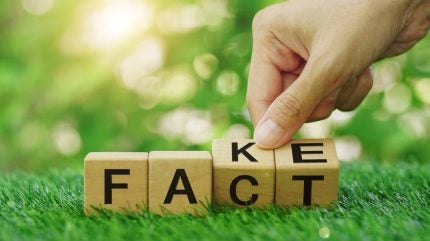
The European Union’s Green Claims Directive, first proposed in March 2023, marks a decisive step towards eliminating misleading environmental marketing across the single market.
Aimed at combating greenwashing and enhancing transparency in product labelling, the directive is set to shape the way companies communicate their sustainability credentials.

Discover B2B Marketing That Performs
Combine business intelligence and editorial excellence to reach engaged professionals across 36 leading media platforms.
For consumers, it promises greater clarity; for businesses, a clearer set of rules to ensure environmental claims are verifiable, accurate, and standardised across the EU.
At the heart of this initiative is the goal of making green claims trustworthy.
As sustainability becomes a key selling point for products ranging from cleaning detergents to clothing and electronics, the EU is moving to prevent vague, unverifiable, or false eco-friendly statements—such as “climate neutral” or “eco-conscious”—unless backed by robust evidence.
The directive aligns closely with the broader aims of the European Green Deal and the Circular Economy Action Plan, both of which seek to build a more sustainable, transparent economy.

US Tariffs are shifting - will you react or anticipate?
Don’t let policy changes catch you off guard. Stay proactive with real-time data and expert analysis.
By GlobalDataWhy the EU is cracking down on greenwashing
Greenwashing—the practice of making unsubstantiated or exaggerated environmental claims—has become increasingly widespread, often leaving consumers confused or misled.
According to a study by the European Commission, over half of environmental claims assessed in 2020 were vague, misleading, or lacked supporting evidence. Phrases like “environmentally friendly” or “natural” frequently appear on packaging without any verifiable proof.
The Green Claims Directive addresses this by introducing strict criteria.
Under the proposed law, any company operating in the EU that markets a product or service with an environmental claim must conduct a thorough, scientific assessment based on recognised methodology.
This includes disclosing the full lifecycle impact of the product, ensuring claims are not selective or misleading, and providing access to detailed substantiation.
One of the directive’s key features is the requirement for third-party verification. Before making any green claim public, businesses will need to submit their data to accredited verifiers for review.
If approved, companies can proceed; if not, they risk fines or having their claims removed. The directive will also prohibit the use of environmental labels that are not backed by recognised certification schemes or national or EU-level verification.
What businesses need to do to comply
For businesses, the Green Claims Directive represents a fundamental shift in how sustainability is communicated. Brands must now adopt a more transparent and evidence-based approach.
This includes conducting environmental footprint assessments using internationally recognised standards such as the Product Environmental Footprint (PEF) or Organisation Environmental Footprint (OEF).
Retailers and manufacturers will need to maintain comprehensive documentation that supports each claim, detailing everything from raw material sourcing to manufacturing emissions and disposal impacts.
The goal is to create a standardised playing field where consumers can easily compare products across the EU.
Businesses that already operate within established environmental certification schemes—such as EU Ecolabel or ISO 14024—may find the transition more straightforward.
However, companies using their own eco-labels or vague language will likely need to overhaul their marketing and compliance strategies. Non-compliance could result in significant penalties, reputational damage, and potential exclusion from certain markets.
Small and medium-sized enterprises (SMEs) will be granted a grace period to adapt to the new rules, recognising the potential administrative burden. The European Commission has also pledged to support SMEs with guidance documents, digital tools, and access to harmonised methodologies.
Benefits for consumers and the environment
The ultimate aim of the Green Claims Directive is to empower consumers to make informed choices based on reliable information. By enforcing clarity and accountability, the EU hopes to foster greater trust in green marketing while pushing companies to make genuine environmental improvements.
For the environment, the ripple effects could be substantial.
Transparent, accurate sustainability claims create incentives for producers to reduce their environmental impact—not just for image, but to remain competitive in a market increasingly driven by eco-conscious consumers.
Over time, this can contribute to reductions in carbon emissions, waste, and resource consumption, supporting the EU’s broader climate targets.
Consumer organisations have welcomed the move, viewing it as a long-overdue response to years of misleading product labelling. Surveys indicate that nearly 90% of EU citizens want better information on the sustainability of the products they buy.
With the new directive, product comparisons will become more straightforward, greenwashing will be easier to spot, and environmental integrity will carry real weight in the marketplace.
Looking ahead
The Green Claims Directive is still progressing through the legislative process, with implementation expected across EU member states by 2026.
Once adopted, it will form part of a broader framework of sustainable consumer laws, including the Directive on Empowering Consumers for the Green Transition and the Ecodesign for Sustainable Products Regulation.
Businesses and marketers should prepare now by auditing existing green claims, updating their verification procedures, and aligning with credible environmental standards.
The shift may be demanding, but in the long term, it will create a more level playing field and build deeper consumer trust.
As climate action becomes an increasingly urgent global priority, the EU’s Green Claims Directive sets a precedent that other regions may follow.
Its impact will extend beyond compliance—it will change how sustainability is communicated, understood, and ultimately, delivered.





